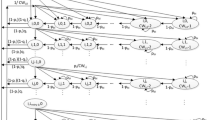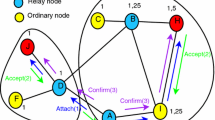Abstract
IEEE 802.15.4m TVWS Multi-Channel Tree PAN (TMCTP) standard that uses the vacant TV frequency of a region is the key to provide a flexible, scalable and cost-effective AMI smart grid networks. However, the performance of the IEEE 802.15.4m based AMI network can suffer from network interruption, varying transmission reliability and energy consumption problems due to the excessive number of channels and periodic channel scanning. To resolve these issues, we presented an enhanced IEEE 802.15.4m TMCTP called TVWS Orphan channel scanning with Multi-Channel Tree PAN Routing (TOMTPR). The proposed TOMTPR framework includes pilot-channel based Multi-Channel beaconing and interleaving-based TVWS orphan channel scanning. Furthermore, a capacity-aware routing tree is constructed during the neighbor discovery procedure. The proposed protocol suite is designed to provide compatibility with the IEEE 802.15.4 family standards with lower architecture complexity. The simulation results in presence of realistic AMI traffic and AMI network model show that TOMTPR can not only satisfy delay requirements of the AMI traffic, but also outperforms IEEE 802.15.4m TMCTP with IEEE 802.15.5 layer 2 mesh routing in terms of topology construction delay, end-to-end transmission reliability, and energy efficiency.


















Similar content being viewed by others
References
Son, S., & Chung, B. (2009). A korean smart grid architecture design for a field test based on power IT. In IEEE PES T&D: Asia and Pacific, Seoul, Korea.
OECD (2009). Towards green ICT strategies: Accessing policies and programmers on ICT and the environment. OECD Digital Economy Papers.
Bryson, J., & Gallagher, P. (2012). NIST framework and roadmap for smart grid interoperability standards, release 2.0. National Institute of Standards and Technology (NIST), Tech. Rep. NIST Special Publication 1108R2.
Erol-Kantarci, M., & Mouftah, H. (2011). Wireless sensor networks for smart grid applications. In IEEE SIECPC, Riyadh, Saudi Arabia.
Gungor, V., Sahin, D., Kocak, T., Ergut, S., Buccella, C., Cecati, C., & Hancke, G. (2011). Smart grid technologies: Communication technologies and standards. IEEE Transactions on Industrial Informatics, 7(4), 629–639.
Kim, J., Kim, D., Lim, K., Ko, Y., & Lee, S. (2012). Improving the reliability of IEEE 802.11s based wireless mesh networks for smart grid systems. Journal of Communications and Networks KICS, 14(6), 629–639.
Yu, R., Zhang, Y., Gjessing, S., Yuen, C., Xie, S., & Guizani, M. (2011). Cognitive radio based hierarchical communications infrastructure for smart grid. Network, IEEE, 25(5), 6–14.
Luan, W., Sharp, D., & Lancashire, S. (2010). Smart grid communication network capacity planning for power utilities. In IEEE PES, New Orleans, USA.
Sheng, Z. et al. (2013). A survey on the IETF protocol suite for the internet of things: Standards, challenges, and opportunities. IEEE Wireless Communications 20(6), 91–98.
Noguet, D., Gautier, M., & Berg, V. (2011). Advances in opportunistic radio technologies for TVWS. EURASIP Journal on Wireless Communications and Networking, 2011(1), 1–12.
Sum, C., Lu, L., Zhou, M., Kojima, F., & Harada, H. (2013). Design considerations of IEEE 802.15. 4 m low-rate WPAN in TV white space. Communications Magazine, IEEE, 51(4), 74–82.
Ruofei, M., Chen, H., Huang, Y., & Meng, W. (2013). Smart grid communication: Its challenges and opportunities. IEEE Transactions on Smart Grid, 4(1), 36–46.
Zhang, Y., Yu, R., Nekovee, M., Liu, Y., Xie, S., & Gjessing, S. (2012). Cognitive machine-to-machine communications: Visions and potentials for the smart grid. Network, IEEE, 26(3), 6–13.
802.15.4m, I. S. (2014). IEEE standard for local and metropolitan area networks—Part 15.4: Low-rate wireless personal area networks (LR-WPANs)—amendment 6: TV white space between 54 MHz and 862 MHz physical layer.
Sum, C., Zhou, M., Lu, L., Funada, R., Kojima, F., & Harada, H. (2012). IEEE 802.15. 4 m: The first low rate wireless personal area networks operating in TV white space. In IEEE ICON, Singapore, Singapore.
Romaniello, G., Potetsianakis, E., Alphand, O., Guizzetti, R., & Duda, A. (2013). Fast and energy-efficient topology construction in multi-hop Multi-Channel 802.15.4 networks. In IEEE WiMob, Lyon, France.
Karowski, N., Viana, A., & Wolisz, A. (2011). Optimized asynchronous multi-channel neighbor discovery. In IEEE INFOCOM, Shanghai, China.
Herberg, U., & Clausen, T. (2011). A comparative performance study of the routing protocols LOAD and RPL with bi-directional traffic in low-power and lossy networks. In ACM PE-WASUN, New York, USA.
Popa, D., Jetcheva, J., Dejean, N., Salazar, R., Hui, J., & Monden, K. (2013). Applicability statement for the routing protocol for low power and lossy networks (RPL) in AMI networks. Internet Draft.
Lee, M., Zhang, R., Zheng, J., Ahn, G., Zhu, C., Park, T., et al. (2010). IEEE 802.15.5 WPAN mesh standard-low rate part: Meshing the wireless sensor networks. IEEE Journal on Selected Areas in Communications, 28(7), 973–983.
Sauter, T., & Lobashov, M. (2011). End-to-end communication architecture for smart grids. IEEE Transactions on Industrial Electronics, 58(4), 1218–1228.
Merlin, S., Vaidya N., & Zorzi, M. (2008). Resource allocation in multi-radio Multi-Channel multi-hop wireless networks. In IEEE INFOCOM, Phoenix, USA.
Chilamkurti, N. et al. (2009). Cross-layer support for energy efficient routing in wireless sensor networks. Journal of Sensors.
Zhang, X. M., et al. (2015). Interference-based topology control algorithm for delay-constrained mobile ad hoc networks. IEEE Transactions on Mobile Computing, 14(4), 742–754.
Meng, T. et al. (2015). Spatial reusability-aware routing in multi-hop wireless networks. IEEE Transactions on Computers, 65(1), 244–255.
Yao, Y., Cao, Q., & Vasilakos, A. V. (2013). EDAL: An energy-efficient, delay-aware, and lifetime-balancing data collection protocol for wireless sensor networks. In MASS, Hangzhou, 14–16 Oct. 2013, pp. 182–190. doi:10.1109/MASS.2013.44.
Yao, Y., Cao, Q., & Vasilakos, A. V. (2015). EDAL: an energy-efficient, delay-aware, and lifetime-balancing data collection protocol for heterogeneous wireless sensor networks. IEEE/ACM Transactions on Networking, 23(3), 810–823.
Liu, X. Y., Zhu, Y., Kong, L., Liu, C., Gu, Y., Vasilakos, A. V., et al. (2015). CDC: Compressive data collection for wireless sensor networks. IEEE Transactions on Parallel and Distributed Systems, 26(8), 2188–2197.
Song, Y., Liu, L., Ma, H., & Vasilakos, A. V. (2014). A biology-based algorithm to minimal exposure problem of wireless sensor networks. IEEE Transactions on Network and Service Management, 11(3), 417–430.
Liu, Y., Xiong, N., Zhao, Y., Vasilakos, A. V., Gao, J., & Jia, Y. (2010). Multi-layer clustering routing algorithm for wireless vehicular sensor networks. IET Communications, 4(7), 810–816.
Busch, C., Kannan, R., & Vasilakos, A. V. (2012). Approximating congestion + dilation in networks via “quality of routing. IEEE Transactions on Computers, 61(9), 1270–1283.
Li, P., Guo, S., Yu, S., & Vasilakos, A. V. (2014). Reliable multicast with pipelined network coding using opportunistic feeding and routing. IEEE Transactions on Parallel and Distributed Systems, 25(12), 3264–3273.
Dvir, A., & Vasilakos, A. V. (2011). Backpressure-based routing protocol for DTNs. ACM SIGCOMM Computer Communication Review, 41(4), 405–406.
Vilajosana, X., Tuset-Peiro, P., Vazquez-Gallego, F., Alonso-Zarate, J., & Alonso, L. (2014). standardized low-power wireless communication technologies for distributed sensing applications. Sensors, 14(2), 2663–2682.
Cuomo, F., & Abbagnale, A. (2013). Cross-layer network formation for energy-efficient IEEE 802.15. 4/ZigBee wireless sensor networks. Ad Hoc Networks, 11(2), 672–686.
What exactly is Advanced Television Systems Committee. http://www.hdtvprimer.com/issues/what_is_atsc.html.
Hossain, K., & Champagne, B. (2011). Wideband spectrum sensing for cognitive radios with correlated subband occupancy. IEEE on Signal Processing Letters, 18(1), 35–38.
Chan, A., Zeng, K., Mohapatra, P., & Lee, S. (2010). Metrics for evaluating video streaming quality in lossy IEEE 802.11 wireless networks. In IEEE INFOCOM, San diego, USA.
Kaabi, F., Ghannay, S., & Filali, F. (2010). Channel allocation and routing in wireless mesh networks: A survey and qualitative comparison between schemes. International Journal of Wireless and Mobile Network, 2(1), 132–151.
SX1272/73—860 MHz to 1020 MHz Low Power Long Range Transceiver. http://www.semtech.com/images/datasheet/sx1272.pdf.
Mohassel, R., Fung, A., Mohammadi, F., & Raahemifar, K. (2014). A survey on advanced metering infrastructure. International Journal of Electrical Power & Energy Systems, 63, 473–484.
Kim, J., Han, J., Ko, Y-B., & Filali, F. (2015). Interleaving-based orphan channel scanning for the IEEE 802.15.4m in TVWS Smart Grid Networks. In IEEE ICUFN, Sapprro, Japan.
Acknowledgments
Following are results of a study on the “Leades INdustry-university Cooperation” Project, supported by the Ministry of Education, Science & Technology (MEST).
Author information
Authors and Affiliations
Corresponding author
Rights and permissions
About this article
Cite this article
Kim, J., Han, J., Mir, Z.H. et al. Efficient topology construction and routing for IEEE 802.15.4m-based smart grid networks. Wireless Netw 23, 533–551 (2017). https://doi.org/10.1007/s11276-015-1164-0
Published:
Issue Date:
DOI: https://doi.org/10.1007/s11276-015-1164-0




